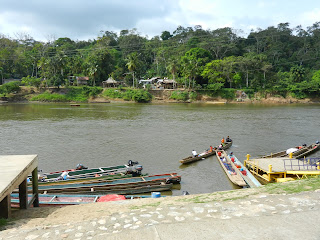This morning I was up before dawn and headed out to the Panama Rainforest Discovery Center to enjoy the morning birds from the canopy tower there. However, a mid-morning rain sent me home a little early than planned, where I started to settle in for the day.
Shortly after arriving at home, I got a phone call from my housemate, who was out for a walk in Gamboa. He said that he just witnessed a falcon hit a window at one of the houses in town and asked if I could come help. I packed up a towel and headed out to see if I could be of any help. I was expecting a Bat Falcon (common in town) or other raptor, but when I got there I was surprised to see a beautiful white-phase Collared Forest-Falcon sitting on the ground. It had hit a large window, rather hard, and had been stunned on the ground. After about 10 minutes, just before I got there, it was able to stand up on its feet. It was still on the ground, standing, when I arrived. It seemed a little shaken up but alert, and I figured if I approached it, it would fly. It didn't appear to have any obvious physical injuries, and that was apparent when it flew a few minutes later. It glazed off another window on the house next door (unfortunately these big windows show a good reflection of the surrounding forest), and landed in a tree in the back yard. It still seemed shocked but ok, and I was happy to see it fly fine and land properly. Still a little concerned, I decided to stick around for a little while and watch it, to see if it would carry on into the forest. It didn't, and I decided to head home, and plan on checking on it later.
 |
| Collared Forest-Falcon in Gamboa |
The Collared Forest-Falcon, Micrastur semitorquatus, is a large forest raptor of the tropical forests of Central and South America, and largest of all the forest-falcons. It has a slim body with long legs and tail, and measures approximately 50 cm in length, with a wingspan up to 80 cm. It comes in three colour morphs - white (pale), buff and dark. The pale and buff morphs show a distinct collar that wraps around the sides of its head, with a dark crescent on the side of the head, and contrasting with its dark brown or black plumage on head, wings, back and tail. It is more commonly heard than seen, often calling at dawn and dusk, low-pitched 'aw" calls. It hunts small mammals including squirrels and other rodents, and birds in the forest understory. In Panama, this species is considered uncommon on both slopes, is found in lowland forest up to an elevation of almost 2000 m. If in Panama or other forests in tropical America, keep your eyes and ears open for this beautiful bird!
~ Jenn















